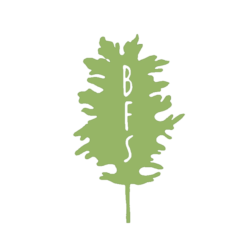By Jordan Tiberi
Jordan Tiberi is an environmental studies major at Wheaton College. As an “interpretive ecologist,” she inventoried pollinators and their habitats at the farm in summer 2021.

Insect Report August 26 by Jordan Tiberi, BFS Intern
Somehow it’s already time for the last Insect of the Week! On Tuesday we saw a spider between two tomato plants that I was personally terrified of at first, so I decided to do some research on it. The yellow garden spider is very common in the eastern United States and though it looks big and scary, it is actually harmless to humans and beneficial to the ecosystem. This spider is venomous, but the venom will not hurt us, only their prey. The spider uses the venom to paralyze its prey when it flies into the web and then immediately wraps the prey in silk. Yellow garden spiders typically feed on garden pests such as aphids, mosquitoes, and beetles as well as dragonflies, damselflies, bees, and wasps. Their webs are very complex and intricate. They spin circular webs with the help of an extra claw on each of their feet. They also create a zig-zag pattern within the web to form an x-shape, called a stabilimentum. The exact function of the stabilimentum is unknown, but one theory is that it alerts birds of the web’s existence to alert them not to fly into it and destroy it. The spiders will eat their web at the end of the night and then build a whole new one the next day, usually in the same area. Females can be up to three times bigger than males, displaying sexual dimorphism, and usually have brighter yellow spots on their abdomen. They will mate in late summer or early fall and the female will then lay egg sacs on her web, which will then usually hatch in the spring. The males die after mating, while the females typically live until the first hard frost of the winter or longer depending on the geographic location and climate. These are big and can be scary, but they are beneficial for the garden so please try not to harm them or their web!
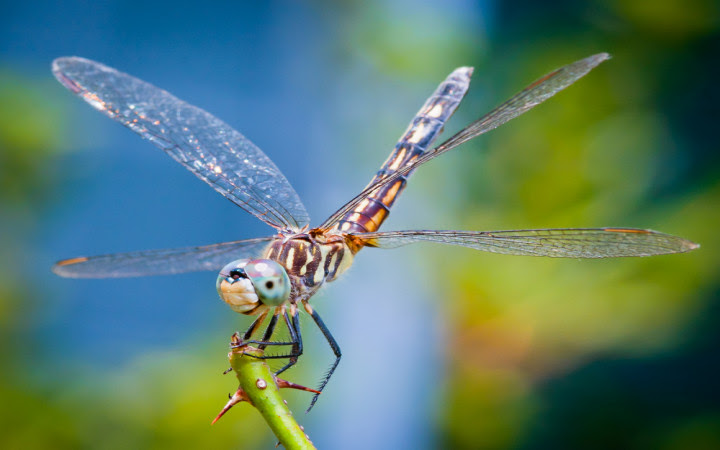
Insect Report August 19 by Jordan Tiberi, BFS Intern
Dragonflies are from the taxonomic group Odonata, which is around 325 million years old. Dragonfly fossils have been found with wingspans of up to 2 feet, which is expected to be from the high levels of oxygen during the Paleozoic era. They are great bioindicators of a healthy ecosystem since they require stable oxygen levels and clean water. There are around 7,000 different species of dragonflies alive today. Females lay eggs immediately after mating by dipping their abdomen into freshwater to release the eggs during the middle of summer. The eggs then hatch after about a week and the nymphs remain in the water for around 3 years, feeding on aquatic insects and mosquito larvae. They molt 6-15 times before completely maturing into an adult. Their last molt occurs when they crawl out of the water and their exoskeleton breaks open and releases the adult form, which then takes about 12 hours to harden. Adults only live for a month or two and feed primarily on hundreds of flies and mosquitoes per day. Dragonflies are also extremely important in ecosystems as predators of mosquitoes and as prey of birds and fish.

Insect Report August 12 by Jordan Tiberi, BFS Intern
Another very important pollinator is the bumblebee. Both honey bees and bumblebees belong to the Apidae family, but honey bees are from the genus Apis, while bumblebees belong to Bombus. Queens typically spend the winter underground and then emerge in the spring to look for a new nest, usually an old rodent nest underground. Once the workers hatch, their cocoons are temporarily used to store nectar because bumblebees do not make and store honey like honey bees do. By the end of the fall, the workers die out and the queen returns underground to then repeat the process all over again in the spring. Bumblebees are amazing pollinators, maybe even the best ones out there. They can even pollinate plants that other pollinators cannot, such as tomatoes. Tomato plants do not actually produce nectar, but bumblebees will visit them anyway to collect pollen, which they obtain by vibrating their wing muscles to shake the pollen grains out of the plant. They even have pollen pockets to store pollen in. There are 49 different species of bumblebees in the United States, split into 3 different categories based on the length of their proboscis (tongue-like tube that helps to feed on nectar). However, 2 species have gone extinct in the past few years in the United States due to habitat fragmentation, diseases, pesticide use, loss of flowers, and more anthropogenic causes. Pollinators make the world go round!

Insect Report August 5 by Jordan Tiberi, BFS Intern
Last week on the farm I saw several beautiful Monarch butterflies and wanted to share some information about them. Monarchs are one of the only migratory insects, heading as south as Mexico for winter and as north as Canada for summer. However, this entire migratory path takes 2-3 generations to complete, as they only live for 2-6 weeks with the exception of the final generation of the year, called the “Super Generation,” which lives for 6-8 months. Females lay 300-500 eggs within a span of 2 weeks and these eggs then hatch in 3-5 days. Monarchs are said to have an internal compass because once they hatch into caterpillars and morph into adult butterflies they know exactly where to go to follow the migratory route. They usually reach Mexico around Día de los Muertos, and tradition says that the Monarchs are the spirits of loved ones returning. Milkweed is the most important plant for this species and without it, the species would not be able to survive. Females lay eggs solely on leaves of milkweed plants and the caterpillars feed on the milkweed until they morph into adult butterflies and then feed on the nectar of the milkweed. Monarchs have even coevolved with milkweed–milkweed developed toxins to deter animals but monarchs evolved to become immune to these toxins and in turn, these toxins make monarchs toxic to predators while they pollinate for the milkweed, meaning they have a mutualistic relationship. Monarch populations are unfortunately decreasing rapidly, around 90 percent just since the 1990s as a result of habitat loss, fragmentation and climate change. One thing we can all do to help these amazing pollinators is planting milkweed in our yards.

Insect Report July 29 by Jordan Tiberi, BFS Intern
Last week on the farm I saw a ton of pill bugs everywhere when we were harvesting, so I did some research to learn more about them. Believe it or not, pill bugs actually are not insects–they are isopods, a type of non-insect arthropod. Some other non-insect arthropods are crustaceans such as crabs and lobsters. Pill bugs are nocturnal and can usually be found under soil, mulch or leaf piles and they feed on decaying plant matter. Experiments in Florida have shown that they are actually very beneficial for soil due to their detritus diet, because this leads to increased nutrients in the soil layers, such as potassium, nitrogen and phosphorus. Females carry their eggs on a pouch on their ventral (stomach) side for about 4-5 weeks. After this period, the eggs hatch but remain in the pouch for another 1-2 weeks, until they are 2 mm long and can fend for themselves. The young then molt 10-15 times in the following 4-5 months until they fully mature and then live for 2-5 years.

Insect Report July 22 by Jordan Tiberi, BFS Intern
Last week on the farm, I saw a huge red paper wasp and I was honestly terrified, so I decided to do some research to see what these insects do for the ecosystem and whether or not they are harmful to humans. Wasps are predators, so they feed on many garden pests such as aphids and caterpillars. However, adult wasps do not feed on these pests, but rather kill them and bring them back to the nest for the young to feed on. The adults feed on sugars such as nectar, so they are actually considered pollinators because they fly to different flowers to find food. When the weather starts becoming warmer, the queen will build a new nest using saliva and vegetation and lay eggs that will then become the worker wasps for the summer. By the end of the summer, the nest may become the size of a basketball! Population is controlled by the winter, because the workers die off by late fall, while the females hibernate. In Australia, where there is no cold winter, the population of a nest may get to around 2 million workers. Wasps are only aggressive when they feel threatened or feel like their young and/or nest is being threatened. They usually only sting out of self defense or to kill their prey. As long as you don’t get too up close and personal, you should be just fine!

info: https://www.nhm.ac.uk/discover/what-do-wasps-do.html
Insect Report July 16 by Jordan Tiberi, BFS Intern
One insect that we’re always seeing and hearing on the farm is the cricket. Crickets are used for various purposes around the world: in China, they are sometimes kept as pets, in Thailand and many other places they are eaten regularly, and here in the USA they are mostly used as pet food for reptiles! Crickets thrive in temperatures between 80 and 90℉, which is why we see and hear so many throughout the summer. They actually chirp more in the summer due to having more energy. This was discovered in 1897 by a physicist named Amos Dolbear, who then created an equation to show this correlation, which is now Dolbear’s Law: Temperature °F = 50 + (chirps per minute – 40)/4. Only males can chirp, and the sound actually comes from rubbing together their serrated wings, not their mouths. Males will chirp to scare off other males or predators, to attract females, and also to celebrate after mating. The life cycle of crickets is only 2-3 months. One female can lay up to 200 eggs throughout her lifetime, depositing eggs into a damp substrate using her ovipositor, a tube-like organ that allows her to bury her eggs as she lays them. The larvae will then become nymphs without wings and they will molt 5-8 times throughout the next month and then eventually develop wings and become an adult.
info: https://cricketcare.org/
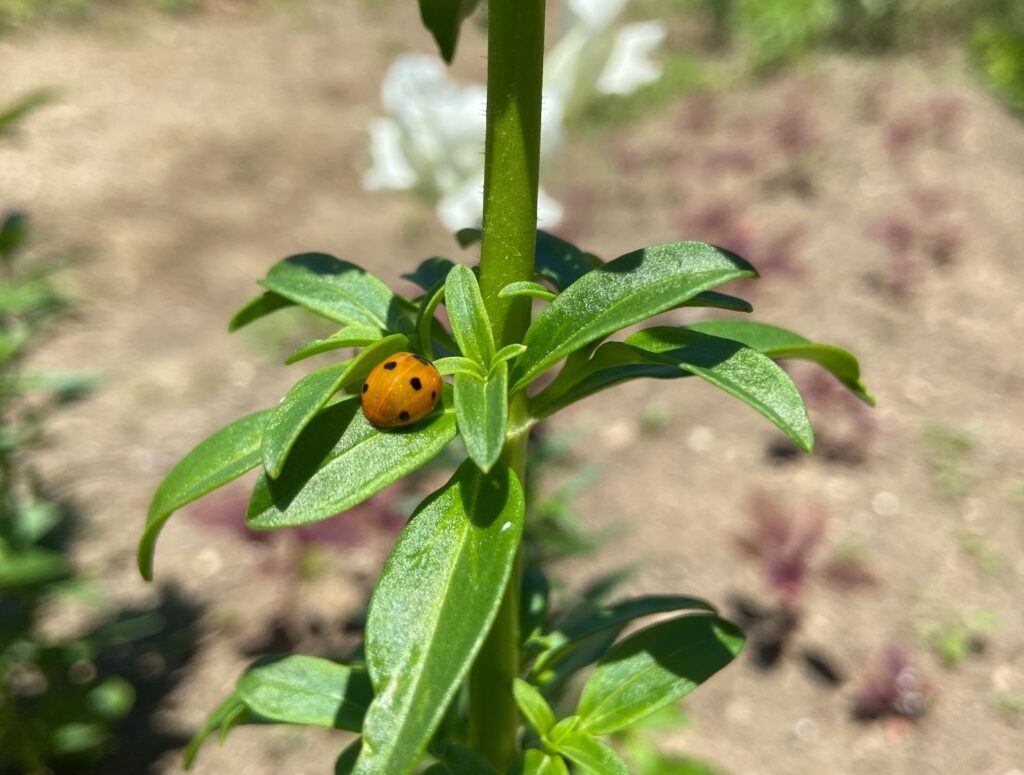
Insect Report July 8 by Jordan Tiberi, BFS Intern
Lately we’ve been seeing lots of ladybugs on the farm, so I wanted to share some information about them. To begin with, there are 5,000 species of ladybugs and they are amazing for farms and gardens because they primarily feed on crop pests, such as aphids, fruit flies, and mites. An adult ladybug can eat up to 75 aphids in one day. Ladybugs usually lay hundreds of eggs at a time in or near aphid colonies, and once the larvae hatch after a few days, they will eat up to 400 aphids each in the two weeks. After these two weeks, they will shed and then enter the pupa stage to start morphing into an adult (as seen in the above picture from the farm). This entire developmental cycle only takes about 4-8 weeks. Ladybugs will group together for diapause (hibernation for insects) and can survive like this for up to nine months. They breakup once the temperature outside reaches 55℉ because this is when plentiful food becomes available. Also, the coloration and spot patterns of ladybugs is actually an adaptation to make them unappealing to predators.
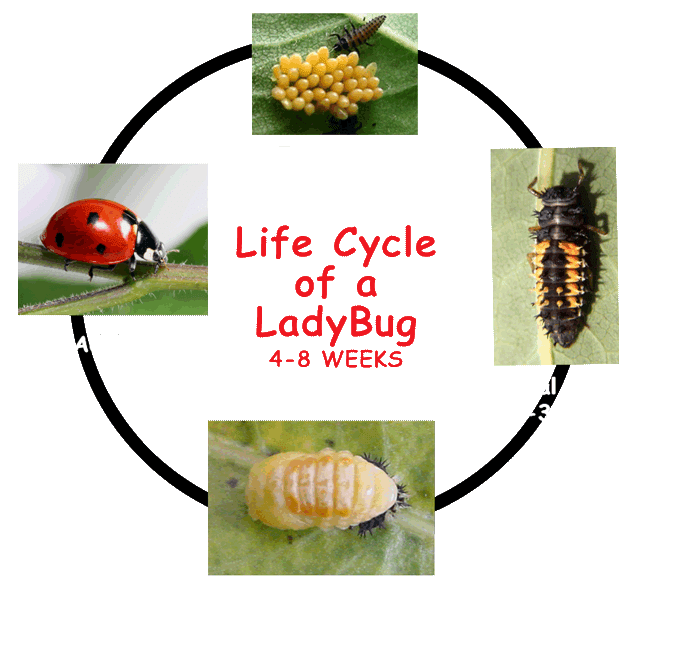
Insect Report July 1 by Jordan Tiberi, BFS Intern
The next insect of the week is the amazing honeybee. A typical hive is divided into three different types of bees: one queen, thousands of workers, and hundreds of drones. The queen is the only bee in the hive that reproduces and can lay up to 1,500 eggs per day during spring and summer. Soon after a queen is born, she will mate with 15 or more drones in the span of 3 days and then remain inside the hive for the remainder of her life, usually around 2-3 years. The drones are males that solely mate with the queen to reproduce. However, immediately after mating, the drone dies. The worker bees are all females and take care of the hive by feeding the larvae, collecting food, guarding the hive, and more and typically only live for 40-50 days. Honeybees feed on nectar and pollen using a proboscis, a long tongue-like appendage that can reach the nectar within the flowers. Honeybees also create propolis, a mixture of tree resin, beeswax, and honey, that can be used to protect and disinfect the hive! Honeybees are very beneficial pollinators and they will only sting if they feel as though it is completely necessary, because stinging you will kill them. Do not be alarmed if you see any in your garden, instead thank them for all the hard work they do!
BFS manages several hives on the farm as part of its education and outreach programs. To learn more, email BarringtonFarmSchool@gmail.com.
Sources: http://www.honeybeecentre.com/learn-about-honeybees#.YMafPalKjAM
Insect Report June 24 by Jordan Tiberi, BFS Intern

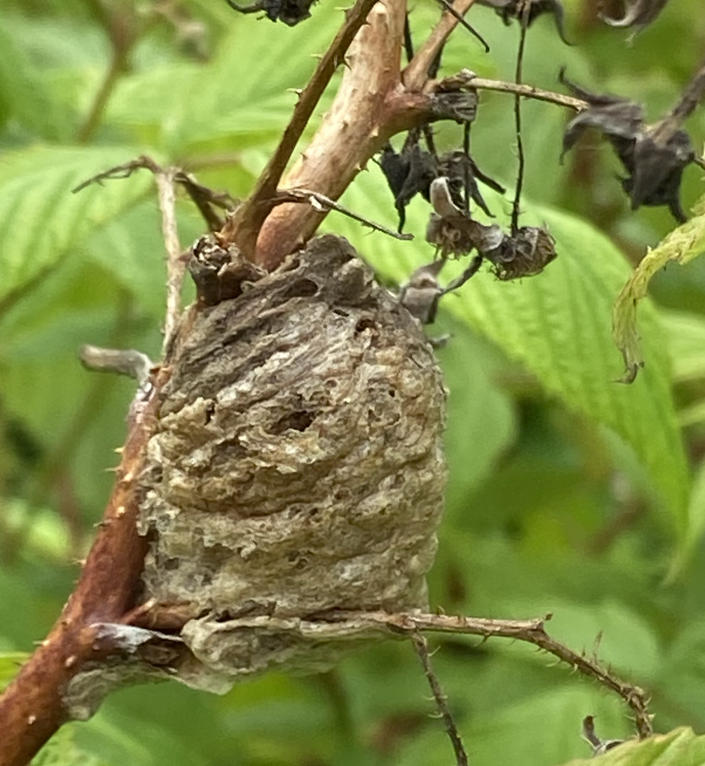
It’s time for the insect of the week! Last week at the farm, someone pointed out a praying mantis “case” to me on the golden raspberry bushes at the back of the farm, so I did some research. Praying mantises are actually carnivorous predators, feeding on moths, flies, grasshopper, crickets, and more. This makes them very beneficial to have in a garden. Females can lay up to 400 eggs in a case to develop over the fall and winter and they then hatch in the spring. Many do not survive, and the stronger siblings may actually feed on their weaker siblings. Praying mantises complete 3 stages of life: egg, nymph, and finally adult.

